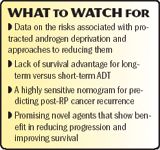Article
Androgen deprivation therapy concerns spur researchers toward alternative treatment for prostate cancer
The emergence of cardiovascular risks associated with androgen deprivation therapy (ADT) has received considerable attention in the urologic and internal medicine communities over the past year.

Key Points
Despite substantive advances in the management of prostate cancer, urologists and their patients still face quandaries and challenges.

"This issue is raising a lot of patient concern nationally," Dr. Thrasher said. "The issue is worrisome because urologists use a lot of androgen deprivation therapy. The concern has reached the point that some members of the urology community are calling for clinical practice guidelines to help urologists deal with this issue."

Adding to the evidence of a growing proportion of non-cancer deaths in prostate cancer patients, another group found that nearly half of a cohort of men with advanced prostate cancer died of non-cancer causes, primarily cardiovascular and respiratory disease. The results included patients who had received ADT for 7 years, ending in 2006. The findings build on those of previous studies from as far back as 1973 that showed high rates of non-cancer death among prostate cancer patients treated with ADT.
Alternate strategies sought
Given the evidence linking ADT to increased risk of non-cancer death, interest has increased in alternative administration strategies that might reduce risk. A prospective, randomized clinical study examined the comparative efficacy, safety, and tolerability of intermittent versus continuous ADT for 2 years. The results showed no statistically significant difference in the rate of androgen-independent progression between the two treatment arms, but intermittent therapy was associated with improved quality of life and a reduction in the occurrence of hot flashes.
Continuing the theme of alternative approaches to continuous ADT, investigators in a multinational study compared outcomes in prostate cancer patients who received short-term (6 months) versus long-term (3 years) ADT. The principal finding was that longer duration of ADT did not improve survival.
Inability to accurately assess a patient's risk of recurrence after prostatectomy has frustrated urologists and patients for years. A predictive nomogram was developed that encompasses patient age, clinical stage, PSA level, Gleason sum, extracapsular extension, surgical margins, seminal vesicle invasion (SVI), and lymph node invasion (LVI). The nomogram demonstrated a high rate of accuracy in identifying patients with an increased risk of biochemical relapse after 2 years. The most important predictors of recurrence were Gleason sum >6, SVI, and LVI, suggesting that early recurrence might be associated with more aggressive cancer.
"More and more people are using nomograms in clinical practice," said Dr. Thrasher. "They can be stored on a desktop or handheld computer. Practicing urologists want tools that are pragmatic, and this is something they can definitely use in the office."
Urologists currently have no clear guidance about how to proceed when a patient's PSA level begins to rise after definitive treatment, Dr. Thrasher noted. Researchers have found that [11C] choline PET/CT imaging after primary treatment has a high sensitivity for detecting recurrence in men with PSA values <2.5 ng/mL.





